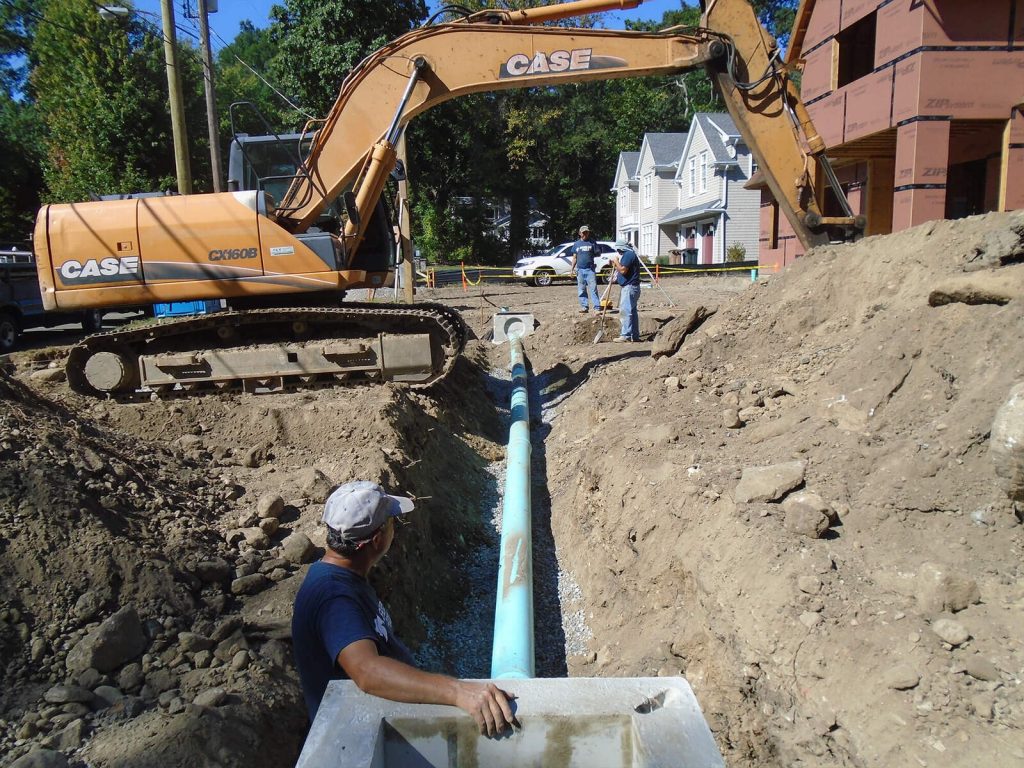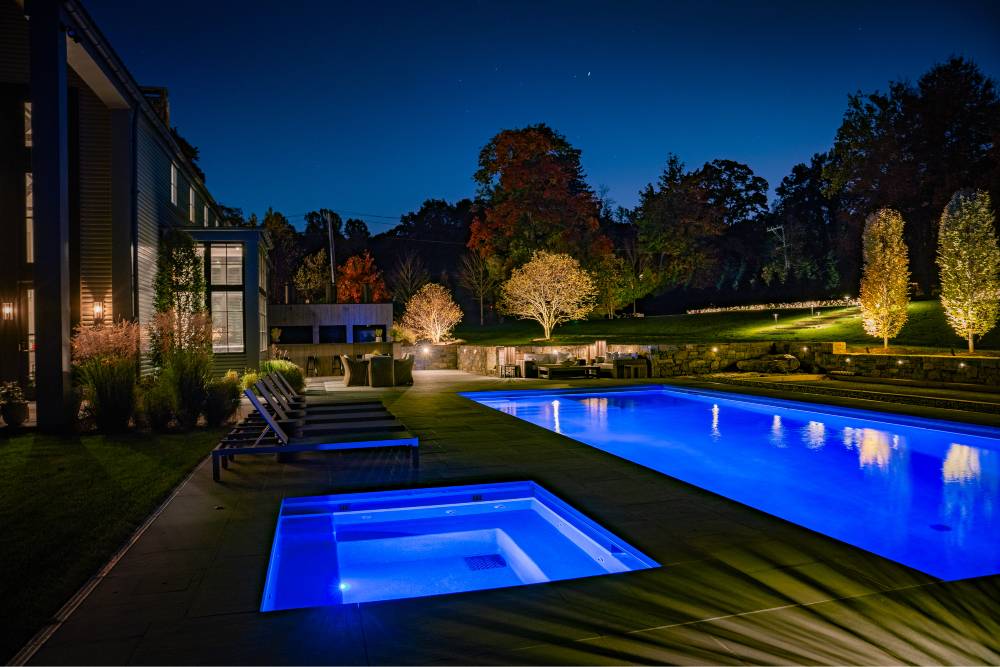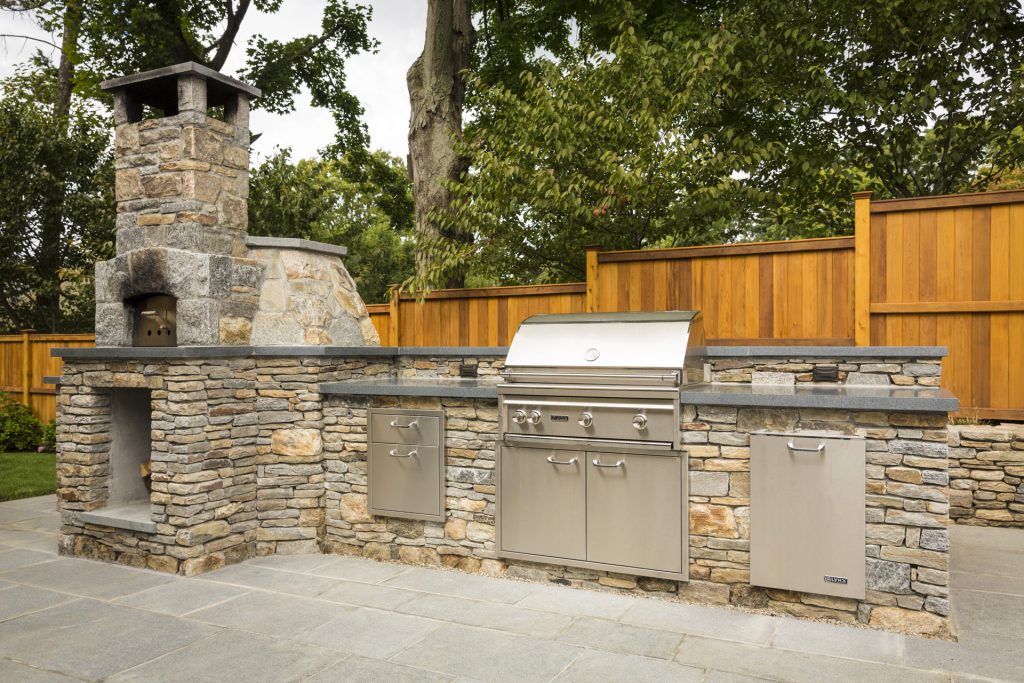Private wells and septic systems are commonplace across the Hudson Valley, especially in Westchester and Dutchess Counties. Even more commonplace is for homeowners in the area to wonder, Can I install a pool if my property has septic or well systems? The answer is yes—when the design follows state and local codes.
Many of the same homeowners searching online for “pool septic Westchester” are trying to learn exactly where a pool can go without disturbing underground systems. Fortunately, both New York State and county health departments provide clear guidelines. Follow them, and your pool and water systems can live in harmony.
To better understand the technical side of pool construction, explore how to build a luxury pool on Westchester rock, which details the process of designing and excavating pools in challenging Hudson Valley terrain.
Quick Answer
Yes, you can build a pool if you have a septic system or well in New York. In-ground pools must be at least 20 ft from septic tanks, 35 ft from leach fields, and 50–100 ft from private wells. Above-ground pools need 10–20 ft of clearance. Local health departments in Westchester, Rockland, and Dutchess verify these distances during permitting.
Why Pool Setback Rules Matter for NY Homeowners
Pools, wells, and septic systems each interact with the same groundwater beneath your property. Without enough space between them, pool water can infiltrate septic zones, or wastewater can leach toward your well. These risks are especially relevant in suburban and semi-rural areas with sloped terrain and shallow soil layers.
New York’s Appendix 75-A, which sets the baseline for residential onsite wastewater systems, defines minimum separations between wells and septic components. Westchester and Dutchess counties expand on these standards to address dense neighborhoods and hilly conditions. Homeowners searching “well setback pool Dutchess” are trying to find out how these county-level details determine whether their yard qualifies for a pool at all.
Understanding New York’s Statewide Pool, Septic, and Well Standards
Appendix 75-A, part of the New York State Department of Health’s Wastewater Treatment Standards – Residential Onsite Systems, outlines minimum distances between water wells, septic systems, and potential contaminants. While pools aren’t listed directly, the rules apply because pools alter the landscape and affect subsurface drainage.
According to Table 2 of Appendix 75-A, absorption (leach) fields must be at least 100 feet from wells, and septic tanks must maintain 50 feet of separation. These distances extend to 200 feet if the septic system sits uphill from the well. The same appendix requires 10 feet from property lines, 10 feet from house foundations, and 20 feet from buildings for safe system function.¹
These figures form the baseline used across Westchester, Rockland, and Dutchess counties when health departments check pool plans on septic properties.
County-by-County Rules: What Westchester, Rockland, and Dutchess Homeowners Need to Know
Pool and Septic Rules in Westchester County
Westchester’s terrain and high property density make pool placement more complex. The Westchester County Department of Health adds specific spacing requirements to the rules set by New York State. They’re in place to prevent groundwater contamination and soil compaction over septic areas.
According to Section 12.B of the county’s Rules and Regulations for the Design and Construction of Residential Onsite Wastewater Treatment Systems and Wells, in-ground pools must be at least 20 feet from septic tanks and 35 feet from absorption fields, while above-ground pools need about 10 feet.
A separate county policy clarifies that in-ground pools must be 50 feet from private wells. Above-ground pools with watertight liners can be as close as 10 feet. This policy ensures that homeowners planning a pool septic Westchester installation follow the same consistent setbacks.
Well and Pool Setback Guidelines for Rockland and Dutchess County Homes
Rockland and Dutchess largely follow the state’s Appendix 75-A standards. But, they maintain independent health departments for plan review. In Dutchess County, the Department of Behavioral and Community Health (DBCH) uses Appendix 75-A and the NYSDOH Individual Water Supply Wells Fact Sheet #6 as references when reviewing pool proposals.
Fact Sheet #6 requires 100 feet between wells and absorption fields and 50 feet between wells and septic tanks. These distances apply throughout the Hudson Valley. Homes on slopes or properties with limited buildable space need these distances.
These numbers plant the seeds for well setback pool in Dutchess. Dutchess County inspectors also verify the condition of septic and well systems before approving new pool construction.
New York Pool Setback Chart: How Far Your Pool Must Be from Septic and Wells
Below is a table summarizing minimum distances from New York State and Westchester County regulations. These are just general guidelines. Local health officials may adjust them based on soil type, groundwater flow, or lot constraints.
| Feature | Minimum Setback to Septic Tank | Minimum Setback to Leach Field / Absorption Area | Minimum Setback to Private Well | Source |
| In-Ground Pool | 20 ft (Westchester) | 35 ft (Westchester) | 50–100 ft (State/County; 50 ft Westchester; 100 ft if upgradient) | Appendix 75-A; Westchester County Regulations; Private Well Policy |
| Above-Ground Pool | 10–20 ft | 10–20 ft (Westchester) | 10–75 ft (10 ft Westchester; up to 100 ft state-based) | Westchester County Health Dept. Policy; Appendix 75-A |
| Property Line | 10 ft | 10 ft | — | Appendix 75-A |
| Dwelling / Building | 10 ft | 20 ft | 50 ft (from septic components) | Appendix 75-A |
These clearances protect drinking water quality and allow septic systems to function properly. For example, the 35-foot separation in Westchester between an in-ground pool and absorption field prevents heavy construction from compacting soil where wastewater disperses.
Does Your Yard Qualify for a Pool with Septic or a Well? Here’s How to Find Out
To begin, get your property survey and confirm the location of septic and well components. If records are missing, your county health department can often provide archived system maps.
Next, figure out the direction your groundwater flows. If your septic system is uphill from your planned pool site, the health department may need greater setbacks. Conversely, if your pool sits downhill, the standard distances usually apply.
Local inspectors measure from the pool’s waterline or excavation edge to the nearest well or septic feature, depending on the rule. Clarifying this early helps ensure compliance and avoids rework during inspection. If your layout meets local requirements, our Ultimate In-Ground Pool Design Guide can help you explore shapes, features, and finishes suited for your space.
Small Yard? Here’s How Variances Can Still Make a Pool Possible
Many Hudson Valley lots lack the space for full clearances. Fortunately, local health departments can issue variances when strict setbacks create hardship.
In Westchester, the Commissioner may grant a variance if the property’s size, shape, or topography makes full compliance unreasonable. Applicants must show that the condition isn’t self-created and that mitigation steps will offset potential risks.
This process allows flexibility for homeowners pursuing pool septic Westchester projects on compact sites. Dutchess County follows a similar process. It requires applicants to prove “maximum feasible separation.” They must also submit engineered alternatives when standard distances can’t be met.
Step-by-Step: Getting Pool Permits Approved on Septic or Well Properties
Building a pool on a septic or well property in New York usually requires two approvals. One from the local building department and another from the county health department.
The building department reviews pool construction, fencing, and electrical safety. The health department focuses on water protection. Applications usually include site plans showing septic and well locations, elevation data, and labeled setback distances. In Westchester, licensed professional must seal engineering drawings.
During review, officials may request soil testing, existing septic certifications, or water quality records. In Dutchess County, inspectors often reference Fact Sheet #6’s separation distances to confirm adequate well setback pool Dutchess compliance before issuing permits.
Once construction is complete, final inspections confirm that setbacks were maintained and that the property was restored properly.
Why Starting Early Prevents Delays and Keeps Your Pool Project on Track
Health department reviews can take several weeks, especially in spring when many applications arrive at once. Starting early—ideally in winter—gives time for surveys, engineering, and design adjustments.
For Westchester homeowners planning pool septic projects or Dutchess residents navigating well setback pool regulations, early engagement with the health department reduces surprises. Even minor site adjustments can bring a design into full compliance and prevent the need for a variance later. Once your permits are approved, check out these essential tips for first-time pool owners to prepare for long-term maintenance and seasonal care.
Key Takeaways
- You can have a pool with septic or well systems in New York. It simply requires meeting state and county setbacks that protect groundwater, usually ranging from 20 to 100 feet depending on your system and site.
- Appendix 75-A sets statewide minimums, but counties like Westchester and Dutchess may add stricter local requirements, such as a 35-foot clearance from leach fields and a 50-foot distance from wells.
- Property surveys are essential. They help identify where septic tanks, leach fields, and wells are located so your designer can plan a compliant layout before applying for permits.
- Small lots can still qualify for pools. Variances are possible when space is limited, provided you propose mitigation strategies such as liners or enhanced drainage control.
- Start planning early. Health department reviews and permit coordination can take weeks or months, especially in the busy spring season. Early submission helps ensure your project stays on schedule.
Safe, Compliant Pool Design for Every NY Home
A septic system or private well doesn’t prevent you from enjoying a backyard pool in New York. It just adds a layer of planning. By following Appendix 75-A and local county regulations, homeowners can protect their drinking water while creating safe, beautiful outdoor spaces.
Whether you’re researching “pool septic Westchester” or trying to meet “well setback pool Dutchess” requirements, the key is early coordination with your local health department and a design team familiar with Hudson Valley terrain. With the right preparation, your property can support both systems safely for years to come.
Resources
New York State Department of Health, Appendix 75-A: Wastewater Treatment Standards – Residential Onsite Systems
Westchester County Department of Health, Rules and Regulations for the Design and Construction of Residential Onsite Wastewater Treatment Systems and Wells
Westchester County Department of Health, Private Well–Swimming Pool Separation Policy
New York State Department of Health, Individual Water Supply Wells: Fact Sheet #6 – Guidance for Code Enforcement Officials




